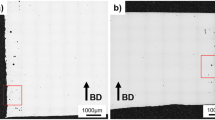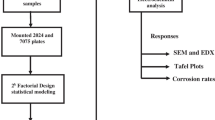Abstract
The galvanic corrosion behaviour of aluminium 3004 - ∝ brass with different area ratios was studied in the tropical marine atmosphere at Tuticorin harbour over a period of 426 days. The area ratios, viz. A Aluminium:A ∝ brass, studied were 0.125, 0.25, 0.5, 1, 2, 4 and 8. The galvanic corrosion behaviour of the metals was studied in terms of the relative increase in the corrosion rate of aluminium due to galvanic coupling with ∝ brass, the relative decrease in the corrosion rate of ∝ brass due to galvanic coupling with aluminium, and the susceptibility of aluminium to pitting owing to galvanic coupling with ∝ brass. The galvanic potential and galvanic current of the system were monitored. Pits of different dimensions ranging from mild etchings to perforations were experienced on the borders and the surfaces of the interface of aluminium in contact with ∝ brass. The corrosion products resulting from galvanic corrosion were analysed using XRD and the pitting on aluminium as a result of galvanic corrosion was highlighted in terms of pit depth, size and density of pit, using a high resolution microscope. The most favourable area ratio of aluminium — ∝ brass in marine atmosphere in terms of gravimetric corrosion rate is 8:1 and the most unfavourable area ratio of aluminium — ∝ brass is 1:4.
Similar content being viewed by others
References
ASTM standards (1991). Wear and erosion, metal corrosion. American society testing and material standard, 3rd ed., Vol. 2, G1–72.
ASTM standards (2003). Standard practice for preparing, cleaning, and evaluating corrosion test coupons. Designation G1-03, ASTM International, West Conshohocken, Pennsylvania, United States, 1–9.
ASTM standards (2005). Standard guide for examination and evaluation of pitting corrosion. Designation G46-94, ASTM International, West Conshohocken, Pennsylvania, United States, 1–8.
Barouni K, Bazzi L, Salghi R, Mihit M, Hammouti B, Albourine A, El Issami S (2008). A study of tetrazoles derivatives as corrosion inhibitors of copper in nitric acid. Materials Letters, 62, 3325–3327.
Campbell HS (1950). Pitting corrosion in copper water pipes caused by films of carbonaceous material produced during manufacture. Journal of the Institute of Metals, 77, 345–348.
Compton KG, Mendizza A (1955). Galvanic couple corrosion studies by means of the threaded bolt and wire test. ASTM 58 th Annual Meeting, Symposium on Atmospheric Corrosion of Non-Ferrous Metals, Philadelphia, 116–125.
Dey AK, Sinha AK Mahapatra, Khan DK, Mukherjee AN, Narain R, Mukherjee KP, Banerjee T (1966). Interim report on atmospheric corrosion studies under marine atmosphere. NML Tech. J. India, 8(4), 11–16.
Doyle DP, Wright TE (1988). Quantitative assessment of atmospheric galvanic corrosion. ASTM Special Technical Publication, STP(978), 161–173.
Gabe DR, El Hassan AM (1986). Potential reversals for aluminium alloy-mild steel galvanic couples in simulated natural waters. British Corrosion Journal, 21(3), 185–189.
Gilbert PT (1948). An investigation into the corrosion of zinc and zinc-coated steel in hot waters. Sheet Metal Industries, Oct.–Dec.
Glass GK, Ashworth V (1985). The corrosion behaviour of the zinc-mild steel galvanic cell in hot sodium bicarbonate solution. Corrosion Science, 25(11), 971–983.
Hoxeng RB (1950). Electrochemical behavior of zinc and steel in aqueous media. Part II. Corrosion, 6, 308–312.
Kucera V, Mattsson E (1982). Atmospheric corrosion of bimetallic structures. W. H. Ailor, Ed., Atmospheric Corrosion, Wiley, New York, 561–574.
LaQue FL (1951). Corrosion testing. Proceedings of American Society for Testing and Materials, Philadelphia, USA, 495–499.
Mansfeld F (1971). Area relationships in galvanic corrosion. Corrosion, 27(10), 136–139.
Mansfeld F, Kenkel JV (1975). Area relationship in galvanic corrosion. Corrosion, 31(8), 298–302.
Mansfeld F, Kenkel JV (1976). Electrochemical monitoring of atmospheric corrosion phenomena. Corrosion Science, 16(3), 111–114.
Markley TA, Forsyth M, Hughes AE (2007). Galvanic corrosion of aluminum alloy (Al2024) and copper in 1.0 M nitric acid. Electrochimica Acta, 52, 4024.
Musa AY, Mohamad AB, Kadhum AAH, Tabal YBA (2011a). Inhibition of aluminium alloy corrosion in 0.5 M nitric acid solution by 4-4- Dimethyloxazolidine-2-thione. Journal of Materials Engineering and Performance, 20, 394–398.
Musa AY, Kadhum AAH, Mohamad AB, Takriff MS (2011b). Inhibition of galvanic corrosion by 4-amino-5-phenyl-4H-1, 2,4-trizole-3-thiol. International Journal of Surface Science and Engineering, 5(2–3), 226–231.
Powell C, Webster P (2012). Copper alloys for marine environments. Copper Development Association, CDA Publication No 206.
Phull BS, Kain RM (2004). Corrosion and protection of structures in marine atmospheres. Structure Magazine, August, 18–20.
Rosenfeld IL (1962). Atmospheric corrosion of metals. Some questions of theory. Proceedings of the 1 st International Congress on Metallic Corrosion, London, 243–253.
Schikorr G (1939). The cathodic behavior of zinc versus iron in hot tap water. Journal of the Electrochemical Society, 76(1), 247–258.
Subramanian G, Palraj S, Balasubramanian TM (1999). Galvanic corrosion interactions of zinc and SS-304 in tropical marine atmosphere of Mandapam. Anti-Corrosion Methods and Materials, 46(5), 332–337.
Subramanian G, Palraj S, Palanichamy S (2014). Galvanic corrosion behaviour of aluminium 3004 and copper in tropical marine atmosphere. Journal of Marine Science and Application, 13(2), 230–236.
Syed S (2006). Atmospheric corrosion of materials. Emirates Journal for Engineering Research, 11(1), 1–24.
Vassie PR, Mckenzie M (1985). Electrode potentials for on-site monitoring of atmospheric corrosion of steel. Corrosion Science, 25(1), 1–13.
von Fraunhofer JA, Lubinski AT (1974). Polarity reversal in the zinc-mild steel couple. Corrosion Science, 14(3), 225–232.
Webster P (2005). The brasses: properties & applications. Copper Development Association, CDA Publication No 117.
Zhang XG (1998). Galvanic protection distance of zinc coated steels under various environmental conditions. Corrosion/98, Houston, Paper No. 747.
Zhang XG, Valeriote EM (1995). Galvanic protection of steel by zinc under thin layer electrolytes. Kirk WW, Lawson HH Eds., Atmospheric Corrosion, ASTM STP 1239, American Society for Testing and Materials, Philadelphia, USA, 230–239.
Author information
Authors and Affiliations
Corresponding author
Additional information
Foundation item: Supported by the CSIR-CECRI under project No. MLP 0008.
S. Palraj is currently holding the post of Principal Technical officer at CSIR-CECRI, Karaikudi. He has a PhD in Chemistry and has been working in the field of Corrosion Testing & Evaluation for the last 31 years. Presently he is involved in the development of antifouling coatings. Besides well cited publications, he has eight Indian patents and one US patent to his credit. Further he has developed 4 processes and commercialized them.
G. Subramanian is currently holding the post of Senior Principal Scientist and Head of OPMEC, CECRI Unit, Tuticorin. He has a PhD in Marine Sciences and his research since 1983 has focused on a range of topics including atmospheric corrosion, evaluation of paints and coatings, marine biofouling prevention and corrosion in seawater. Besides well cited publications, he has seven Indian patents and one US patent to his credit. He has also commercialized a process.
S. Palanichamy, senior scientist, holds a PhD degree in marine sciences at CSIR-CECRI, Tuticorin. He was instrumental in establishing a strong database on chemical oceanographic features of coastal ocean waters, including the Tuticorin and Mandapam regions. Simultaneously he also investigated the effects of water chemistry and local pollution on corrosion and biofouling phenomena. Currently he is developing antifouling formulations from marine natural products.
Rights and permissions
About this article
Cite this article
Palraj, S., Subramanian, G. & Palanichamy, S. Galvanic interactions of aluminium 3004 and ∝ brass in tropical marine atmosphere. J. Marine. Sci. Appl. 13, 455–461 (2014). https://doi.org/10.1007/s11804-014-1274-6
Received:
Accepted:
Published:
Issue Date:
DOI: https://doi.org/10.1007/s11804-014-1274-6




